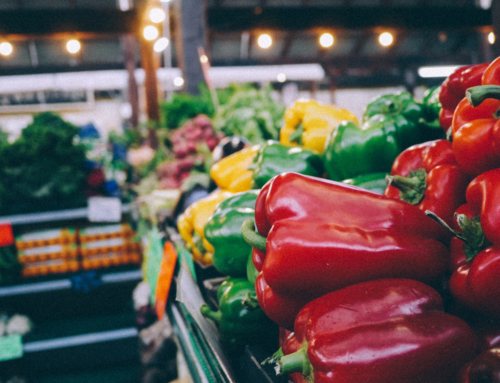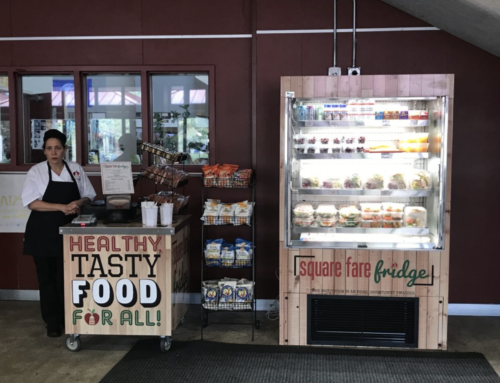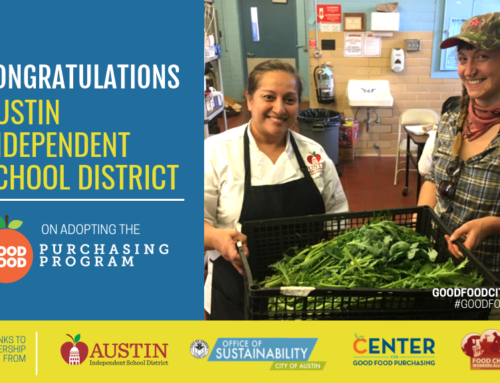One rainy day last fall, Anneliese Tanner scrolled through photos of sweet potatoes on her phone.
The managers at some of the 114 school cafeterias under her watch in the Austin Independent School District were posting photos of the vegetables as their cooks made baked sweet potatoes for the first time. All morning long, Tanner kept an eye on how everyone was reacting to the change.
“They have a lot of pride in their work,” she says. “They like to show off their kolaches and parfaits, especially.”
Like countless other dishes served in the schools, those kolaches and parfaits are handmade, a fact that continues to surprise parents and Austinites who think school food is … well … something else.
Being able to see what’s going on in all the schools every day has been a huge boost for Tanner, a finance-turned-food-policy savant originally from San Antonio, but it’s far from the most revolutionary change she’s implemented in her 18 months in the position.
Tanner left the world of managing retirement portfolios in pursuit of something that would leave “a different kind of legacy,” enrolling as a food policy grad student at New York University with the intention of becoming a school food services director.
“When I was in finance, I was in this phase where I was making my own bread and ketchup and mayonnaise, and I had this really naive notion that people should make all their own food and eat healthier and do things the way I did them,” she says.
Living in the country’s biggest city, Tanner, now 33, realized how this labor-intensive way of cooking was not feasible for the vast majority of Americans. “It’s only fun when you get to choose to do it, and there’s a benefit for our quality of life not to do those things. I don’t think anyone wants us to go back to subsistence living.”
That was just one of the reality checks she had about food during the course of all her careers, which included working as a seafood distributor in New York City, trading containers of food between the U.S. and Asia. “That’s where I learned the power of volume, and I realized that if I wanted to change food, change happens through education and volume, and that’s what we have in the school system,” she says.
Tanner got a job as a supervisor with the Aramark-run food services program at the Round Rock school district, but within three years of finishing graduate school she applied for the top job in the Austin district and found herself in charge of feeding 84,000 students.
Tanner didn’t waste any time getting to work. “My very first priority has been Breakfast in the Classroom,” she says. By the end of this school year, nearly 30 schools will be offering free, universal breakfast to students as they enter the classroom, including hot sandwiches made in the cafeteria each morning.
The district is now serving 5,000 more breakfasts per day, an increase from 23 to 29 percent of enrolled students, with fewer tardies and absences to boot, Tanner says.
Texas requires schools with more than 80 percent of students eligible for free and reduced-cost lunch to serve universal free breakfast, but not necessarily Breakfast in the Classroom, a program where students eat the hot breakfast or cereal in the classroom with their teacher and peers. Tanner wanted to expand Breakfast in the Classroom to schools with more than 60 percent of students eligible for free and reduced lunch.
“It’s the absolute best way to make breakfast accessible to students,” she says, and increasing food access is crucial when 1 in 3 children in Central Texas experiences food insecurity. Students eating together with their teacher helps everyone start the day off on the right foot, and it helps reduce the stigma of eating school food in general.
This was the first year that they went to scratch cooking for the breakfasts, and it took some adjustment for the staff, mostly in the advanced planning.
“We have to think more like a restaurant operation. You have to think three days before, two days before and day of with each item. You have to have the dough and sausages thawed to wrap and proof and bake and cool and package by the time the students walk in the door,” she says.
They’ve added positions in some schools to handle the extra load, a piece of evidence to support Tanner’s point that good food in schools means more jobs in the local economy, from cooks in the kitchens to farmers in the fields.
Eventually, Tanner would like to see 50 percent of students eating breakfast in the school and 75 percent of them eating lunches.
That goal might seem unrealistic, but if you walk through an Austin school cafeteria now you might for a second think that you were in Whole Foods. There might be roasted drumsticks seasoned with Moroccan spices; bright cherry tomatoes and cucumber slices from the same farms that sell at the farmers market; banh mi sandwiches and Indian curry with perfectly cooked zucchini and squash.
The high schools get their hot dog buns from Texas French Bread, a new partnership since Tanner took the helm, and Johnson’s Backyard Garden has fields full of carrots that will be served in the district this semester thanks to an innovative partnership that has the schools buying directly from the farm instead of a distributor.
And you won’t find a better blueberry cobbler, not even at Grandma’s house, than the one they served at the Thanksgiving lunches this year.
Local school districts have been improving the quality of food they’ve been serving for years, but Tanner wanted to see the district leverage its considerable buying power to serve higher quality food to more students, more consistently.
A few years ago, the Texas Department of Agriculture launched a Farm Fresh Fridays campaign to challenge schools to serve locally sourced produce on Fridays. Even without any additional funding from the department, schools across the state have increased their local food spending.
In Austin, Fridays weren’t enough. Tanner decided that if they were going to forge these buying relationships for one day a week, they could do it for three, so now Farm Fresh Fridays takes place Mondays and Wednesdays, too.
The marketing works. More parents send their kids to eat the school lunch on Fridays, which Tanner credits to the local food campaign. If those students ate the school lunch on the other two days a week that feature local produce, the schools could do even more.
“Higher volume ultimately means higher quality because of the increased buying power,” and that means that previously unrealistic changes, such as serving organic milk, grass-fed beef or antibiotic-free chicken, are now within reach.
The school district’s efforts to buy better quality ingredients from local businesses fit in well with the city of Austin’s Good Food Purchasing program, an initiative to harness the buying power of big institutions to benefit the local economy and support the city’s sustainability goals.
Tanner hopes that they’ll eventually spend 65 percent of their food budget locally and 25 percent on organic. Right now, they are at 47 percent local spending last year, with a much longer way to go on the organics side, which is around 4 percent.
Tanner is already seeing food suppliers changing their production methods and sourcing to meet the district’s increasingly rigorous standards. They should soon have a vendor who can provide grass-fed beef patties for hamburgers, and after the upcoming bid season, all but two of their chicken products will come from antibiotic-free chickens.
“We have a vendor who came to us. He sells carnitas and barbacoa. I said, ‘I need a clean label, and here are the seven ingredients you can’t have on it. Get a clean label and we can talk,’” she says.
Months later, he’s become as passionate as Tanner is about providing better quality ingredients to as many people as possible. “It was a competitive business opportunity for him,” she says. “The volume gives us the chance to change the way things are made.”
Another big win in the past year has been an increase in the number of after-school meals served to students who participate in sports, tutoring or other afterschool activities. When Tanner started, only nine schools were offering this option, but now they are serving 4,000 additional after-school meals a year from more than 70 campuses.
To bump up lunch sales at Anderson High School, the district opened a food truck last year that did well enough that they decided to add a second truck, which starting next month will rotate between the other 13 high schools.
Salad bars are yet another way that Central Texas’ largest school district is educating kids about healthy eating habits and providing access to new flavors.
The majority of elementary schools in Austin are now serving themed entree salads twice a week that look more like what you’d order at a restaurant than what you’d assemble from an all-you-can-eat salad bar. For instance, last week at Sanchez Elementary they served a winter harvest salad with a choice of ingredients that included chicken or turkey, homemade croutons, pumpkin seeds, roasted cauliflower, sweet potatoes and carrots.
A handful of campuses across the district had salad bars when Tanner started, but she wanted more uniformity. “I don’t want to do something at two schools,” she says. “I want to do it at 114 schools.”
With the support of the Whole Kids Foundation and the Life Time Foundation, two local nonprofits that support community wellness projects, the district has been able to install these more curated salad bars in more than 50 elementary campuses. By the end of the year, all 80 elementary schools will have them, and then they’ll start piloting in the middle schools, followed by high schools. The financial support from Life Time and Whole Kids also helped buy Vitamixes and food processors to help cafeteria staff chop whole vegetables and make dressings.
“We’re teaching them that salads don’t have to be a side and that vegetables should be the center of the plate,” she says.
Louis Ortiz, the charismatic culinary instructor you might have taken a class from at Central Market, is now the executive chef for the district, and whenever a school gets their new salad bar, he spends a few days with the staff to give them additional knife skills and culinary training so they understand the scientific how, not just the practical why, of the food they are preparing.
Ortiz has also been key in developing recipes for globally inspired dishes that not only send a message to kids from all over the world that they are welcome here but also teach cultural foodways to all students.
“We have a diverse city, so we have to have a diverse menu to meet the needs of all of our students,” Tanner says. “But I also tell my team, ‘The cafeteria is a classroom, and it’s not just nutrition; it’s the food system and cultural foodways, too.’”
For instance, with two dual-language Vietnamese schools in the district now, Tanner and her team added banh mi and pho to the menu served at all the schools, not just the two with a focus on that language and culture.
Increased demand for vegetarian meals means that schools have a hummus plate available on most days, but also that they are serving vegan lentil chili Frito pie that has a 25 percent take rate. Let that soak in: A quarter of students pick lentils for lunch.
On a lunch date with my youngest son last fall, I wished I would see more of the students try the yellow chicken curry with squash that I thought was so delicious. Sampling such newer dishes is the only way to get kids to open their minds to picking them over familiar ones, so Tanner hopes to see an increased take rate over time.
“Kids are having moments of discovery, and they are never going to learn to like it if we don’t serve it,” Tanner says. “If a kid says, ‘What are migas?’ this is exactly why we have migas on the menu. Now this kid is going to know what they are.”
The importance of this subtle shift in menu planning became clear during a work session with Whole Foods chef Tien Ho, who was helping Tanner and her staff design the new mobile food truck and the global sandwich recipes for the menu. “When his family immigrated to Houston from Vietnam, he didn’t speak English and went to school and didn’t recognize the food,” Tanner says. “He said, ‘Now I have the opportunity to make at least one student feel comfortable. That’s really exciting.’”
Although Tanner’s goal is to have 75 percent of students eating the school lunch, that number is now 53 percent, 2 percent lower than last year. Tanner isn’t too frustrated by that number, though. She knows that the lingering stigma of what school lunch might have looked like when parents were in school will start to go away the more that students come home asking about hummus and roasted organic carrots.
She encourages families to apply for the free and reduced lunch program, even if they don’t think they need it or qualify. “The district has so many programs that the community wants it to offer, but if our community understood that by filling out that form, that could mean more teachers, books, computers, there’s no reason not to.”
Indian Chicken and Vegetable Curry
This curry is mild enough to appeal to all kinds of eaters. In Austin school district elementary schools, where this dish was served last month, cooks use seasoned fajita chicken meat, but you could use any kind of pre-cooked (or leftover) chicken. You could also leave it out to make a vegetarian version.
1 Tbsp. butter
2 tsp. minced garlic
1/3 cup chopped onion
2 cups canned garbanzo beans, drained and rinsed
2 1/2 tsp. curry powder
1 1/2 cups vegetable broth
2 tsp. lime juice
1 cup sliced yellow squash
1 cup sliced zucchini
1/8 tsp. salt
6 oz. cooked chicken strips
1 Tbsp. chopped cilantro
2 cups brown rice, cooked, for serving
Melt butter in a large pot over medium low heat. Add minced garlic and onion and cook about 5 minutes until softened. Add drained and rinsed garbanzo beans and stir. Add half of the curry power and continue cooking for 6 to 8 minutes, stirring. Add the vegetable broth, raise the heat on the stove and bring to a simmer. Cover and cook for 5 minutes. Add remaining curry powder, lime juice, squash, zucchini, salt and chicken. Lower the heat slightly, stir, cover and cook for 5 to 7 minutes. Mix in cilantro and serve over rice.
— Adapted from a recipe from the Austin Independent School District Food Services Department





